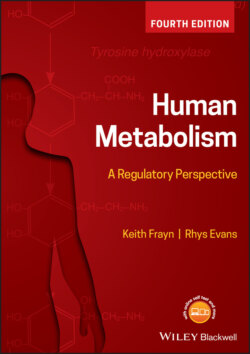Читать книгу Human Metabolism - Keith N. Frayn - Страница 29
1.3.1.4 Tricarboxylic acid (TCA) cycle
ОглавлениеOxidation of the 2-carbon acetyl (CH3·CO–) group of acetyl-CoA is achieved by the TCA cycle within the mitochondrial matrix, with the energy from the oxidation of one acetyl group released in the form of electrons (associated with a hydrogen atom as a hydride (H− ion; see Section 1.2.1.3)) and carried by NAD+ (×3 per acetyl group, i.e. per turn of the cycle) and FAD (×1) in their reduced forms (NADH; FADH2). In addition, one step involves a substrate-level phosphorylation – a chemical step which is directly linked to the phosphorylation of ADP (or GDP) to ATP (or GTP) without the need for mitochondrial oxidative phosphorylation – converting GDP into GTP (or ADP into ATP in some cells).
In the TCA cycle (Box 1.5), the 2-carbon acetyl group of acetyl-CoA combines with oxaloacetate (4 carbons) to form the 6-carbon compound citrate (a TCA, hence the name of the cycle; it is also referred to as the citrate cycle or Krebs cycle). The citrate undergoes two decarboxylation reactions, yielding both the two carbon dioxides and 2 NADH (‘oxidative decarboxylation’ reactions), to form succinyl-CoA (4 carbons). The remainder of the cycle concerns regenerating oxaloacetate from the succinyl-CoA: this process involves the (substrate-level) phosphorylation of GDP to GTP and two further oxidations, yielding the FADH2 and the third NADH, together with the oxaloacetate.
